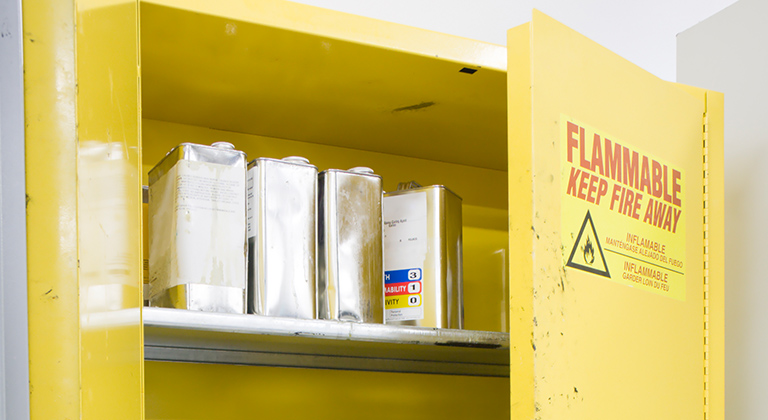Storing flammable liquids
Properly storing chemicals can help reduce the risk of fire and explosion
Chemicals and other flammable liquids are a necessary part of your business. But having them on site means taking some extra safety precautions—especially if you have a large amount of them.
If you use more than four or five one-gallon or larger containers, or 12 or more smaller containers of flammable or combustible liquids, you need a storage cabinet to protect them. It’s a safe and convenient way to store liquid containers—including those in safety cans.
The National Fire Protection Association (NFPA) 30, Flammable and Combustible Liquids Code, sets storage cabinet requirements. While it’s possible to make your own cabinet following NFPA 30 rules, we recommend commercially available cabinets since they’re the easiest way meet your protection needs. A number of companies produce approved and listed cabinets. You can also find similar cabinets for larger 55-gallon drums or smaller containers like those used in laboratories.
Here are the guidelines you should follow when storing flammable and combustible liquids:
Don’t store more than 120 gallons of flammable or combustible liquids in a single cabinet. Of that 120 gallons, only 60 of it can be Class I and II liquids. Class I and II are defined below.
Keep doors closed and latched. If there are automatic doors, make sure they completely close if heat were to break the fusible link.
Place all liquid storage containers in the cabinet when not in use.
Use any vents on the cabinets, if they’re supplied. Make sure you:
Place flame arrestors on all openings
Run the vents to a safe location, usually outside the building. Otherwise, close the vents so flammable vapors can’t escape into the room.
Label each cabinet with: Flammable—Keep Fire Away.
Store only flammable and combustible liquids in the cabinet—not acids, caustics, or other nonflammable hazardous materials.
We also recommend you don’t put more than three cabinets in one area. However, if it’s an industrial operation, an additional cabinet or three-cabinet group is allowed if it’s separated by at least 100 feet from other cabinets or groups.
Definitions
So what kind of flammable and combustible liquids are we talking about? They’re actually divided into three classes that you need to understand.
The first you’ll encounter are flammable liquids that are considered Class I and have flash points below 100°F and a vapor pressure not exceeding 40 psia at 100°F. You can look at the material Safety Data Sheet (SDS) for the physical data of each liquid substance. Class I liquids are subdivided this way:
Class IA: Flash point below 73°F and boiling point below 100°F
Class IB: Flash point below 73°F and boiling point at or above 100°F
Class IC: Flash point at or above 73°F and below 100°F
You might also encounter combustible liquids that have a flash point at or above 100°F. Here’s how they’re subdivided:
Class II: Flash point at or above 100°F and below 140°F
Class IIIA: Flash point at or above 140°F and below 200° F
Class IIIB: Flash point at or above 200°F
This gives you an idea of how to help protect your employees and your business if flammable liquids are a part of your operation.
Related resources
Managing cell phone distractions
Cell phone use while driving is a distraction for your driver. We’ll explain how you help can manage it.
Safety around equipment cabs
We’re dedicated to helping you be aware of safety risks. One area that’s sometimes overlooked is getting in and out of equipment. We have some tips to help.






